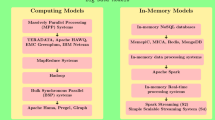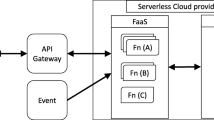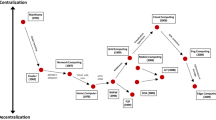Abstract
In this paper, a mathematical model is presented to identify the impacts of events with dynamic and interactive nature on the functionality of resource discovery. This mathematical model can recognize those events with the dynamic and interactive nature having an impact on the functionality of resource discovery and thus failure of resource discovery. To extract the mathematical model by which to recognize the failure of resource discovery due to the occurrence of events with the dynamic and interactive nature, a mathematical function that describes the functionality of resource discovery should be determined. To this end, in addition to the description of this function in traditional computing systems, a function describing the functionality of resource discovery is redefined based on the events with dynamic and interactive nature. The functionality of resource discovery during the occurrence of events with the dynamic and interactive nature as well as different ways for the failure of resource discovery due to the impacts of the dynamic and interactive events in distributed exascale computing systems are examined. Determining the type of failure and describing the cause of failure, as well as recognizing an event with the dynamic and interactive nature that leads to failure of resource discovery helps the resource management to prevent failure of resource discovery by changing those features that may cause the failure of resource discovery. The obtained mathematical model is analyzed in two frameworks named PMamut and Cactus. The capability of each framework to recognize events with dynamic and interactive nature based on the usage of the mathematical model are examined. Overall, the model can recognize 52 to 75% of the events that cause a failure of resource discovery.





Similar content being viewed by others
References
Khethavath P et al (2013) Introducing a distributed cloud architecture with efficient resource discovery and optimal resource allocation. 2013 IEEE Ninth World Congress on Services IEEE
Adibi E, Khaneghah EM (2018) Challenges of resource discovery to support distributed exascale computing environment. Azerbaijan Journal of High Performance Computing 1(2):168–178
Mirtaheri SL, Sharifi M (2014) An efficient resource discovery framework for pure unstructured peer-to-peer systems. Computer Network 59:213–226
Werner H, Bornhoevd C (2020) Metadata-based general request translator for distributed computer systems. U.S. Patent No. 10,706,046
Dongarra J et al. (2014) Applied mathematics research for exascale computing. No. LLNL-TR-651000. Lawrence Livermore National Lab.(LLNL), Livermore,
Souri A, Navimipour NJ (2014) Behavioral modeling and formal verification of a resource discovery approach in grid computing. Expert Systems with Applications 41(8):3831–3849
Khaneghah EM, Aliev AR, Bakhishoff U, Adibi E (2018) The influence of Exascale on resource discovery and defining an indicator. Azerbaijan Journal of High Performance Computing 1(1):3–19
Khaneghah EM et al. (2018) Challenges of load balancing to support distributed exascale computing environment. Proceedings of the International Conference on Parallel and Distributed Processing Techniques and Applications (PDPTA). The Steering Committee of The World Congress in Computer Science, Computer Engineering and Applied Computing (WorldComp)
Messina P (2017) Update on the exascale computing project (ECP). HPC User Forum
Khatibi E, Sharifi M, Mirtaheri SL (2020) DPAS: a dynamic popularity-aware search mechanism for unstructured P2P systems. Peer-to-Peer Networking and Applications 13(3):825–849
Noghabi HB, Ismail AS, Ahmed AA, Khodaei M (2012) Optimized query forwarding for resource discovery in unstructured peer-to-peer grids. Cybernetics and Systems:687–703
Adibi E, Khaneghah EM (2020) ExaRD: introducing a framework for empowerment of resource discovery to support distributed exascale computing systems with high consistency. Cluster Computing:1–21
Saleh R, Saeidi et al (2018) A mathematical framework for managing interactive communication distortions in exascale organizations. Cogent Business & Management 5(1):1545356
Fahmideh M, et al. (2020) Process patterns for service oriented development. arXiv preprint arXiv:2004.09381
Djamaa B, Yachir A, Richardson M (2017) Hybrid CoAP-based resource discovery for the internet of things. Journal of Ambient Intelligence and Humanized Computing 8(3):357–372
Navimipour NJ, Milani FS (2015) A comprehensive study of the resource discovery techniques in peer-to-peer networks. Peer-to-Peer Networking and Applications 8(3):474–492
Harchol-Balter M, Leighton T, Lewin D (1999) Resource discovery in distributed networks. ACM, Proceedings of the eighteenth annual ACM symposium on Principles of distributed computing
Navimipour NJ et al (2014) Resource discovery mechanisms in grid systems: a survey. Journal of Network and Computer Applications 41:389–410
Chen W (2011) Distributed device discovery framework for a network. U.S. Patent No. 7,962,605. 14 Jun
Trunfio P et al (2007) Peer-to-peer resource discovery in grids: models and systems. Future Generation Computer Systems Syst 23(7):864–878
Basu S et al (2005) Nodewiz: peer-to-peer resource discovery for grids. CCGrid 2005. IEEE International Symposium on Cluster Computing and the Grid 1. IEEE
Cokuslu D, Hameurlain A, Erciyes K (2010) Grid resource discovery based on centralized and hierarchical architectures. International journal for Infonomics 3(1):227–233
Frey J, Tannenbaum T, Livny M, Foster I, Tuecke S (2002) Condor-G: a computation management agent for multi-institutional grids. Cluster Computing 5(3):237–246
Yousif A et al (2011) A taxonomy of grid resource selection mechanisms. International Journal of Grid and Distributed Computing 4(3):107–117
Dakkak O, Nor SA, Arif S (2016) Proposed algorithm for scheduling in computational grid using backfilling and optimization techniques. Journal of Telecommunication, Electronic and Computer Engineering (JTEC) 8(10):133–138
Sharifi M, Mirtaheri SL, Khaneghah EM (2010) A dynamic framework for integrated management of all types of resources in P2P systems. Journal of Supercomputing 52(2):149–170
Camp DR (2006) Escape to a new dimension: a journey through space with a square, a cube, and a tesseract. Mathematics Teacher 100(3):180–183
Mirtaheri SL et al (2013) Four-dimensional model for describing the status of peers in peer-to-peer distributed systems. Turkish Journal of Electrical Engineering & Computer Sciences 21(6):1646–1664
Khaneghah EM (2017) PMamut: runtime flexible resource management framework in scalable distributed system based on nature of request, demand and supply and federalism. U.S. Patent No. 9,613,312. 4 Apr.
Khaluf Y, Pinciroli C, Valentini G, Hamann H (2017) The impact of agent density on scalability in collective systems: noise-induced versus majority-based bistability. Swarm Intelligence 11(2):155–179
Allen G, Angulo D, Foster I, Lanfermann G, Liu C, Radke T, Seidel E, Shalf J (2001) The cactus worm: experiments with dynamic resource discovery and allocation in a grid environment. The International Journal of High Performance Computing Applications 15(4):345–358
Lofgren BM (2014) Simulation of atmospheric and lake conditions in the Laurentian Great Lakes region using the Coupled Hydrosphere-Atmosphere Research Model (CHARM)
Coniglio MC, Elmore KL, Kain JS, Weiss SJ, Xue M, Weisman ML (2010) Evaluation of WRF model output for severe weather forecasting from the 2008 NOAA hazardous weather testbed spring experiment. Weather Forecast 25(2):408–427
Author information
Authors and Affiliations
Corresponding author
Additional information
Publisher’s note
Springer Nature remains neutral with regard to jurisdictional claims in published maps and institutional affiliations.
Rights and permissions
About this article
Cite this article
Adibi, E., Khaneghah, E.M. A mathematical model to describe resource discovery failure in distributed exascale computing systems. Peer-to-Peer Netw. Appl. 14, 1021–1043 (2021). https://doi.org/10.1007/s12083-020-01067-1
Received:
Accepted:
Published:
Issue Date:
DOI: https://doi.org/10.1007/s12083-020-01067-1




